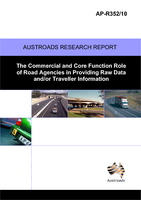Agency Management

The Commercial and Core Function Role of Road Agencies in Providing Raw Data and/or Traveller Information
- Publication no: AP-R352-10
- ISBN: 978-1-921709-08-1
- Published: 4 April 2010
- PDF (free) Download
The purpose of this document is to report on the traveller information industry within Australia, how RAs are using real time traffic data to manage traffic congestion on their road networks, what access policies and pricing strategies are being employed by RAs who provide real time traffic data to CTPs and what methods of communication are best suited to gathering and disseminating this information to the motoring public given the interest being expressed by the CTPs in this regard. Most Road Agencies (RAs) in Australia currently provide traffic data to consultants, internal departments and external Commercial Third Parties (CTPs) and have set up various agreements and commercial arrangements affecting the way that this information is being used. Current practice is typically for CTPs to enter into a data licence agreement with the RA that governs the basis on which traffic data is provided by the RA and is used by the CTP. Austroads has called for assistance to develop an informed and agreed basis for decision making by RAs in relation to the management and/or distribution of traffic data being collected and distributed in this way.
- AP-R352/10 The Commercial and Core Function Roleof Road Agencies in Providing Raw Data and/or Traveller Information
- Austroads profile
- CONTENTS
- FIGURES
- EXECUTIVE SUMMARY
- 1. INTRODUCTION
- 1.1. Project Background
- 1.2. Road Agency Investment
- 1.3. Access to Traveller Information
- 2. CURRENT INDUSTRY TRENDS
- 2.1. The Role of the Road Agency
- 2.2. Commercial Third Party Interests
- 2.3. The Value Added Information Chain
- 2.4. Agreements Currently in Place
- 3. REVIEW OF INDUSTRY PRACTICE
- 3.1. Road Agency Consultation
- 3.2. Commercial External Third Party Consultation
- 3.3. Interpretation of the Results
- 4. DATA CUSTODIANSHIP AND STANDARDISATION
- 4.1. Data Collection and Communication Protocols
- 4.2. Emerging Interest in Public Sector Information and Data
- 4.3. Capturing the benefits of using Spatially Referenced Data Sets
- 5. ROAD AGENCY MANAGEMENT AND CONTROL
- 5.1. Matching Expectations
- 5.2. Opportunities versus Threats
- 5.3. Legal Models/Approaches
- 6. EMERGING INTERNATIONAL TRENDS
- 6.1. Data Collection
- 6.2. Information Dissemination
- 6.3. Reduced Reliance on Fixed Object Information Gathering
- 6.4. New Players in the Australian Marketplace
- 7. SHARING IN THE FUTURE
- 7.1. Recognising the Role of the Private Sector
- 7.2. Traveller Information Industry Business Models
- 7.3. Data Access and Pricing Options
- 8. CONCLUSIONS AND RECOMMENDATIONS
- 8.1. Confirming the Role of the Road Agency
- 8.2. Adopting the Right Business Model
- 8.3. Access and Pricing Policies
- 8.4. Establishment of a National Framework for Cooperation
- 9. REFERENCES
- 10. ACKNOWLEDGEMENTS
- 11. APPENDIX A
- INFORMATION RETRIEVAL
Related publications
WEB-GADA-24
WEB-R695-G104-2-23
Latest Agency Management News
